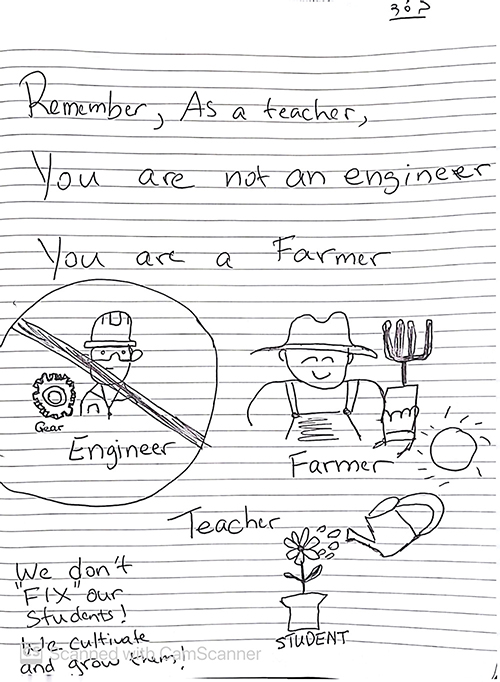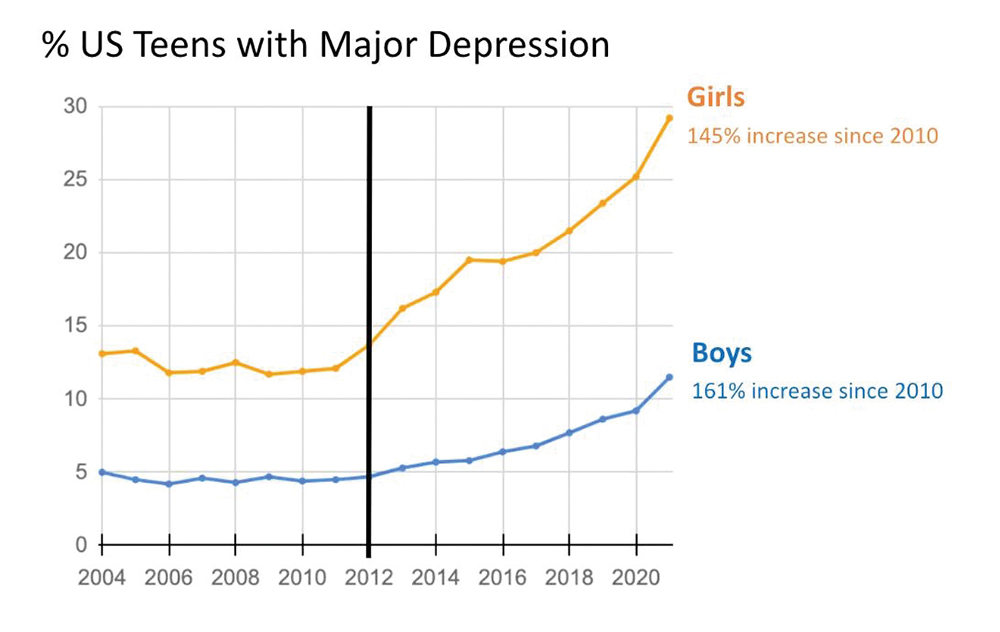
For the past few summers, I have had the privilege to participate in a teacher institute at MIT, one of the world’s premier technology research institutions, and hardly a bastion of Luddites. At the institute, we spent time every day journaling—by hand, with pen and paper—something I had not done in many years. I found the experience of writing notes by hand to be enlightening. I even tried my hand at sketchnoting, something we were taught how to do during the program. In sketchnoting, you combine your handwritten notes with symbols and pictures; basically it’s doodling with a purpose. I am hardly an artist but I found the act of sketchnoting helped me think deeply and creatively about the material we were learning since I naturally think in pictures, which is why I love creating my Parsha Memes. You can see an example of a page of my sketchnotes from the institute below.
So why am I, a tech enthusiast, talking about the value of writing notes with pen and paper? Because for many, if not most of us, taking notes by hand is superior in terms of comprehending and retaining information to taking notes digitally on a computer. You can read the research here (https://tinyurl.com/writtenvsdigitalnotes) summarized with the help of Bing AI Chat powered by ChatGPT.
However, this is not true for all learners. Certainly students with dysgraphia benefit from taking notes on a computer. Computerized notes are also easier to search and store for future use. I myself am thankful that when I started teaching way back in the 1990s, I chose to write all my lesson plans and teaching notes using a computer, so I still have access to everything that I have taught in the past 27 years with just a few clicks on my laptop, while my notes from college, rabbinical school and graduate school are collecting dust in my crawl space. Digital note taking can be transformational but, at the same time, should supplement, not replace, writing notes by hand. Here are some suggestions to combine the two. One can write notes by hand and then scan them using the Notes app or Camscanner on your phone. Or one can retype your handwritten notes later as a review, something I did often when I was at MIT.

Handwritten notes are just one of the benefits many of our teens miss out on in this digital age. A more serious issue, we should all be mindful of, is the ambivalent relationship we have with our smartphones. The launch of the iPhone in 2007 and its Android clones which soon followed has transformed our world. Entire industries like the taxi industry, the Yellow Pages, the hospitality industry, and even the humble AAA TripTik have been upended by this pocket-sized device. We now always have access to a calculator, despite what my fifth-grade teacher told me when she was making me memorize the multiplication tables, and we carry virtually all of human knowledge at our fingertips.
But has this made us healthier, well-balanced human beings? Cal Newport, noted computer scientist and bestselling author of “Deep Work,” has pointed out the negative relationship between teen mental health and the rise of the smartphone. You can read a transcript of his talk here https://tinyurl.com/kidsandsmartphones. I will summarize his findings below.
In 2012, researchers started to notice a disturbing rise in mental health related issues among our teens. You can see a chart of this below. Note, most of this data is pre-COVID so the isolation our children experienced due to school closings and social distancing is not the reason for this rise in mental illness, although the pandemic might have accelerated these numbers even further.
Many theories developed regarding the cause of this steep rise in mental illness. Perhaps the worldwide economic meltdown was to blame. But that happened five years prior in 2007 and 2008. Others attributed it to the presidential elections. But the rise was reported worldwide, not just in the U.S., and the 2012 election between Barack Obama and Mitt Romney was not nearly as politically charged as many previous elections in recent history. Some argued that it was not really a rise at all but just due to a greater awareness of mental illness in society. But the rise was not just apparent in self-reporting but in hospital admissions due to teens attempting self-harm, something much more likely to reflect real change.
Soon a consensus began to develop around one likely culprit, the smartphone. You see, 2012 was a seminal year in the history of the smartphone. It was the first year that more Americans owned a smartphone than did not. And the number of smartphone users has continued to rise as the number of teens with mental health issues has risen in parallel. In 2017, the Atlantic published a seminal article documenting this, titled “Have Smartphones Destroyed a Generation?”

In May of this year, the U.S. Surgeon General came out with an advisory identifying the most significant cause of this mental health risk to teens on their smartphones: the use of social media. The warning described how apps like Snapchat, Instagram and TikTok can lead to a “heightened emotional sensitivity” leading to lower life satisfaction amongst teens, especially teenage girls. Teens on social media often experience FOMO, the fear of missing out, as they see all their friends seeming to be having so much fun while they are home on their phone in their bed. And social media and the ubiquity of smartphones everywhere require our kids to always perform, to dress perfectly and look just right. They never have the time to just be kids, as anything they say or do can be documented for all to see.
So what can be done?
Banning smartphones or social media is not the answer. Firstly, there are many benefits to using these devices and social media apps in a positive way, what noted technology thinker Clay Shirky calls Cognitive Surplus. Just think of social media platforms like Thank You Hashem, Meaningful People and Simcha on Wheels and all the good they spread to a worldwide audience that would have been unimaginable back when I was in high school.
Furthermore, bans don’t work. Our kids would just go underground to do much more harmful activities without our knowledge or guidance. I remember a number of years ago when a famous Chasidic Jewish educator came to speak about kids and technology. After his talk, I asked him what I should do as a parent if my child asked for a Facebook account. This was back when Facebook was still cool and not taken over by our kids’ Bubbies. His response surprised me. He said, “Get your own Facebook account and tell her that she can use Facebook as long as she makes you her first friend.”
We can’t ban computers, smartphones or social media but we can model for our children its effective use. Here are some suggestions.
1) Encourage your children to use their computers and smartphones for research, communication and creative pursuits but make sure they don’t throw away the old tried and true “technologies” like handwritten note-taking and face-to-face conversations.
2) Try to delay the age your child signs up for social media accounts whenever possible. Middle-school age is often too young for kids to learn to use apps like Instagram and TikTok effectively.
3) Even when they get these apps, require them to set them to private, friend or follow you, and set strict time limits on the use of these apps. The iPhone’s Screen Time feature makes it very easy to set a one hour a day limit on social media use. You can learn more about this feature here: https://tinyurl.com/screentimehowto
4) And when kids are home, especially during mealtime and homework time, require them to put away their phones. And that goes to parents as well. Put your phone away. Even if you need to go to another room in order to check it every 10 minutes, this is much better than being constantly connected to your phone.
These suggestions are not easy but they are essential for us and our children to live a healthier, more balanced life. And we have a head start over the rest of humanity. We already have 25 hours each week when we unplug to reconnect with our friends and family and our creator in order to refresh our minds and souls. We have Shabbos.
Rabbi Tzvi Pittinsky is the director of educational technology at Yeshivat Frisch. He is also the author of the Parsha Memes, which appear weekly in The Jewish Link. You can email him at parshamemes@gmail.com.










